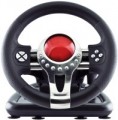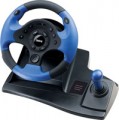Number of buttons
The total number of buttons provided in the design of the manipulator.
The more buttons — the more additional features you can "tie" to the manipulator, the lower the likelihood that during the game you will have to turn to other controls (for example, a PC keyboard). However, many game consoles (see "Platform Compatibility") provide a certain minimum number of buttons for a compatible gamepad — a smaller number simply would not allow full use of all the functions of the console. For example, the original PlayStation 4 controller has 11 buttons.
Note that the D-Pad (see below) is not included in this calculation: it is considered a specific control, although it is based on buttons.
Steering wheel turn
The angle of rotation of the steering wheel in the manipulator-steering wheel (see "Device type"). This parameter is measured over a general range — from one extreme point to another; accordingly, the angle of rotation from the middle position will be half the total. For example, a figure of 180° means that the steering wheel is capable of turning to the right and left by 90°.
Both the general level and the purpose of the steering wheel directly depend on this parameter. Models with a rotation angle of up to 270° are predominantly entry-level and are intended mainly for fans of arcade racing without much emphasis on realism, as well as for children and novice gamers. In more advanced rudders, the steering angle is already
900 °, or even 1080 °. These numbers are taken for a reason — they correspond to the steering wheel ranges in most production cars (900 °), as well as some sports supercars (1080 °). Thus, such characteristics make the use of the steering wheel as realistic as possible — on the other hand, they significantly affect the cost.
The steering wheel rotation range can be adjusted by the
steering wheel angle adjustment function (if such a feature is implemented in the game controller). The option is configured either directly in the game, or through the software that controls the operation of the steering wheel.
Transmission
The type of gearbox provided in the steering wheel (see "Device type").
—
Gear lever. The switch is in the form of a classic lever, as on most serial cars. To work with such a lever, you need to remove your right hand from the steering wheel, but this is not a drawback, but a characteristic feature — this is how everything happens during real driving, and many users appreciate this option precisely for realism. At the same time, the device of the gearshift lever can be different: in the simplest steering wheels it moves back and forth, allowing only sequential gear changes, in more advanced ones it allows you to immediately engage any gear, like on a real manual gearbox.
—
Paddle shifters. Switches in the form of petals located under the steering wheel (more precisely, behind the wheel, when viewed from the user's side). This method is used in premium passenger cars, as well as many racing cars. Gear shifting is carried out only sequentially; on the other hand, you do not need to remove your hand from the steering wheel, which increases the reaction speed and provides full control over the steering.
— Gearshift lever and paddle shifters. The presence at the steering wheel of the two methods of gear shifting described above. This allows the user to choose the option of their choice, depending on preferences and the situation: for example, in fast-paced racing, it is more con
...venient to use the paddles, and in a leisurely truck simulator, the lever provides more realism.Table mount
A method of attaching a game pad to a table or other surface. Note that not all types of devices (see above) use mounts — gamepads, for example, do not need them by definition, and the pedals are made on a massive stable base and installed on the floor, so they also do not need latches. In other cases, the following options may be provided:
—
Suckers. Classic suction cups that "stick" to the surface of the table. Such fixtures require a fairly flat surface, but in most cases this is not a problem, given the materials used for modern tables. Another advantage of suction cups is that they can be mounted anywhere on the table — not necessarily on the edge, as is the case with many clamps. Among the disadvantages of this option, one can name the fact that as the material of the suction cups wears out, it loses its elasticity, and the reliability of fastening decreases — especially with frequent attachment / detachment. On the other hand, in most cases, the period of effective operation of suction cups is quite comparable with the life of the manipulator itself, so this disadvantage is usually not critical.
—
Clamps. Clamps usually take the form of characteristic clamps that allow you to mount the device on the edge of the table top or in another similar place. The main advantage of this option can be called reliability: firstly, a well-clamped clamp holds the manipulator in place much more tig
...htly than suction cups, and secondly, the quality of fastening practically does not deteriorate even with frequent attachments and detachments. On the other hand, the clip can only be used on the edge of a tabletop or on a special stand, which limits the choice of where to install the game pad.
— Bolts. A specific variant used mainly among high-end flight simulator instruments (see "Device type"); almost never found in other types of controllers. With the help of bolts, the instrument clusters are installed in a special rack that imitates the cockpit of an aircraft.
There are models that allow several mounting options: for example, the steering wheel with suction cups can also be equipped with a clamp, which allows you to choose the option at the discretion of the player.Power source
The power source used by the gamepad.
This parameter directly depends on the type of connection (see "Connection"). So, power from a
USB port or
network (power supply) is provided mainly in wired models, and devices with wireless connectivity (both purely wireless and combined) are almost guaranteed to use a
battery or
batteries. Here is a more detailed description of each of these options:
— USB port. Powered by a USB port — usually the same one through which the controller directly interacts with the console, PC or other gaming device. This method of connection allows you to do without unnecessary wires. On the other hand, USB power is relatively low, which makes this option poorly suited for controllers with powerful feedback systems (in particular, advanced steering wheels) — you have to use separate PSUs with such accessories (see below).
Also note that this power supply method is also found in separate wireless models — usually controllers for mobile devices that interact with the gadget via Bluetooth, and are powered from the USB port of the same gadget. This format of operation allows you to do without batteries in the controller itself, however, it additionally consumes the charge of the main device.
— Network. Powered from a conventional outlet using a separate power supply unit (PSU). Mainly used
...in high-end wired wheels (see Device Type) that require high power for feedback systems to work effectively. Theoretically, this option is not very convenient, as it requires the search for an additional outlet; however, in fact, this usually does not cause any particular difficulties (in extreme cases, you can use an extension cord).
— Accumulator. Powered by a built-in battery that does not belong to standard sizes (unlike batteries), and often also non-removable. This is the most popular way of powering wireless manipulators nowadays. Its main advantage over batteries is that this option does not require extra money and effort: the battery is initially included in the package, you do not need to buy it separately, and when the charge is exhausted, it is enough to charge the controller. However this procedure requires a certain time; however, the time for a full charge rarely exceeds a couple of hours, while the operating time can be measured for days (although there are also more modest figures). In addition, many controllers can be used without unplugging the charger; this somewhat limits mobility, but this moment is usually not critical.
— Batteries (AA, AAA). Powered by replaceable cells of a standard size — usually "finger" AA or "little" AAA. The number of elements used can be different; however, the general features of such a power supply are the same in all controllers. On the one hand, the batteries allow quick replacement, which allows you to play with a minimum of interruptions: when the charge is exhausted, it is enough to simply install fresh batteries instead of dead ones. At the same time, the user has a choice: either regularly buy disposable batteries, or invest in rechargeable batteries with an external charger. And if you purchase two sets of such batteries, you can keep one set on charge while the second is in use. On the other hand, the use of batteries is inevitably associated with additional costs: batteries are usually not included in the kit, and they must be purchased separately before the first use. As a result, this type of power is used much less frequently than batteries, although it can also be found in fairly advanced and well-known devices — in particular, regular gamepads for Xbox 360, Xbox One and even Xbox Series X|S.
